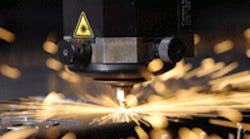For decades, manufacturers have used punch presses to cut materials. They were reliable technology that everyone understood how to use. Times, however, are changing. Laser cutting machines are gaining traction among manufacturers looking for better edge quality, automation and speed.
Frank Arteaga, head of product management for laser-cutting producer Bystronic, says laser-cutting devices are getting both more precise and more affordable as the technology for the machines gets better.
"More and more people are getting away from punch presses," Arteaga says. "They're entering a world where laser cutters are getting more affordable and produce better products."
Jason Hillenbrand, laser product manager for Amada America, headquartered in Buena Park, Calif., says the downturn hit laser manufacturers like his particularly hard, but they are starting to see a rebound in the market.
Photo: Bystronic
Laser-cutting machines do more than just speed up fabrication and make it more precise, Arteaga says. The automation of the fabrication process saves time and money for manufacturing, boosting profits and making them more competitive internationally.
"Laser cutting automates the process and takes out some of the potential for human error," Arteaga says. "Even the unloading process is automated, which saves the companies significant money."
"Automation is critical," agrees Hillenbrand. "It really gives you an advantage if you can use laser cutters to help keep your business lean."
Gaining New Business
Paul Blaisdell, director of fabrication for McNeilus Steel Inc., says his company resisted the move toward fabrication for decades, preferring to remain solely a steel distribution company. But in recent years, customers started to demand more value-adds if McNeilus wanted to keep their business.
"We were dragged into the laser-cutting arena by our customers," Blaisdell says. "We never wanted to be fabricators, but our customers told us that we had to start fabricating or they would buy their steel from someone else. That's a great motivator."
Blaisdell says the company has invested in eight laser cutters to give them the capability to fabricate parts for their customers. That segment of the company is now 20% of its overall business and continues to grow at the fastest rate of any other group in the company.
"Switching to laser cutting brought in new customers and solidified relationships we had with old customers," Blaisdell says. "It's become its own profit center."
The debate in companies deciding whether to purchase lasers at the moment centers on whether to purchase traditional CO2 lasers or the newer technology, fiber lasers. CO2 lasers work better with thicker materials, while fiber lasers are more cost-efficient if you're cutting thinner materials. Fiber lasers save money because they don't have mirrors that can get scratched up or damaged, and the cost of the mixture of gases (typically nitrogen, helium and CO2) is eliminated.
"Fiber lasers are just in their infancy, but they are quickly gaining ground," Arteaga says. "Depending on what you're cutting, it can give you up to 50% in cost savings."
Blaisdell says McNeilus uses CO2 lasers because the company thinks they cut faster and the cut quality at this point in their development is better.
"We've been watching the fiber laser market for the past two years, and at some point we'll end up purchasing some of them as well," Blaisdell says. "Right now, however, our needs require that we use CO2 lasers, and we're happy with them."
See Also:
• Oracle Enters the Environmental Reporting Business




